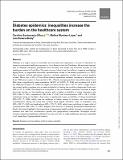Mostrar el registro sencillo del ítem
Diabetes epidemics: inequalities increase the burden on the healthcare system
| dc.creator | Santamaría Ulloa, Carolina | |
| dc.creator | Montero López, Melina | |
| dc.creator | Rosero Bixby, Luis | |
| dc.date.accessioned | 2019-11-14T15:43:24Z | |
| dc.date.available | 2019-11-14T15:43:24Z | |
| dc.date.issued | 2019 | |
| dc.identifier.issn | 1460-2237 | |
| dc.identifier.uri | https://hdl.handle.net/10669/79848 | |
| dc.description.abstract | Diabetes is a major cause of morbidity and mortality and represents a source of demands on already constrained healthcare systems in Latin America and the Caribbean. We estimate inequalities in diabetes incidence, prevalence and mortality and assess the economic burden on the healthcare system in Costa Rica. The main source of data is the Costa Rican Longevity and Healthy Aging Study, a longitudinal nationally representative survey of the elderly population (n = 2827). Data analyses include descriptive statistics, multiple regression models and survival analysis models. More than a fifth of Costa Rican elderly experience diabetes. Incidence is estimated at 5 per 1000 person-years in the population 30+. Gender and geographical inequalities were found. Men have a significantly lower prevalence (16.51% vs 24.02%, P < 0.05) and incidence (4.3 vs 6.0 per 1000 person-years, P < 0.05), but higher mortality (hazard ratio = 1.31, P < 0.01). Longer time to the closest facility translates into a lower probability of having the condition diagnosed [odds ratio (OR) = 0.77, P < 0.05]. The diabetic as compared to the non-diabetic population imposes a larger economic burden on the healthcare system with a higher probability of using outpatient care (OR = 3.08, P < 0.01), medications (OR = 3.44, P < 0.01) and hospitalizations (OR = 1.24, P > 0.05). Individuals living in the Metro Area have a significantly lower probability of being hospitalized (OR = 0.72, P < 0.05), which may be evidence of better access to primary care that prevents hospitalization. Along the same line, women have higher utilization rates of outpatient care (OR = 2.02, P < 0.01) and medications (OR = 1.73, P < 0.01), which may contribute to lower odds of hospitalization (OR = 0.61, P < 0.01). Aligned with the aim of attaining Sustainable Development Goals, this study highlights the importance of generating health policies focused on prevention of diabetes that take into consideration gender and geographical inequalities. Strategies should booster preventive healthcare utilization by men and aim to make healthcare services accessible to all, regardless of geographical location. | es_ES |
| dc.language.iso | en_US | es_ES |
| dc.source | Health Policy and Planning, 34(Supplement_2), ii45-ii55 | es_ES |
| dc.subject | Diabetes | es_ES |
| dc.subject | Sistemas de atención de la salud | es_ES |
| dc.subject | Desigualdades | es_ES |
| dc.title | Diabetes epidemics: inequalities increase the burden on the healthcare system | es_ES |
| dc.type | artículo original | |
| dc.identifier.doi | https://doi.org/10.1093/heapol/czz109 | |
| dc.description.procedence | UCR::Vicerrectoría de Investigación::Unidades de Investigación::Ciencias de la Salud::Instituto de Investigaciones en Salud (INISA) | es_ES |


